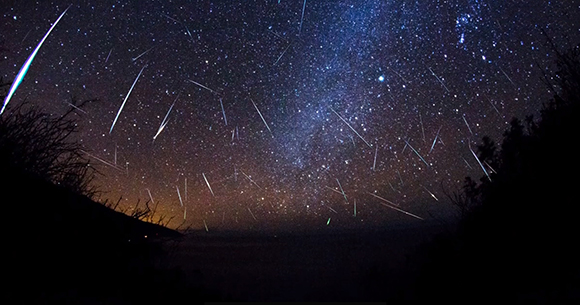Best Nights for Viewing Geminids Meteor Shower Set for December 13-14
By Space Coast Daily // December 2, 2022
best annual meteor shower

(NASA) – The Geminids are widely recognized as the best annual meteor shower a stargazer can see, occurring between Dec. 4 to Dec. 17, with the best nights for viewing on Dec. 13 and 14.
The parent of the Geminids is 3200 Phaethon, which is arguably considered to be either an asteroid or an extinct comet. When the Earth passes through trails of dust, or meteoroids, left by 3200 Phaethon, that dust burns up in Earth’s atmosphere, creating the Geminid meteor shower.
The Geminid rate will be even better this year, as the shower’s peak overlaps with a nearly new moon, so there will be darker skies and no moonlight to wash out the fainter meteors. That peak will happen on the night of Dec. 13 into the morning of Dec. 14, with some meteor activity visible in the days before and after. Viewing is good all night for the Northern Hemisphere, with activity peaking around 2:00 a.m. local time, and after midnight for viewers in the Southern Hemisphere.
Why are they called the Geminids?
All meteors associated with a shower have similar orbits, and they all appear to come from the same place in the sky, which is called the radiant. The Geminids appear to radiate from a point in the constellation Gemini, hence the name “Geminids.”
How fast are Geminids?
Geminids travel 78,000 mph (35 km/s). This is over 1000 times faster than a cheetah, about 250 times faster than the swiftest car in the world, and over 40 times faster than a speeding bullet!
How to observe the Geminids?
If it’s not cloudy, get away from bright lights, lie on your back, and look up. Remember to let your eyes get adjusted to the dark – you’ll see more meteors that way. Keep in mind, this adjustment can take approximately 30 minutes. Don’t look at your cell phone screen, as it will ruin your night vision!
Meteors can generally be seen all over the sky. Avoid watching the radiant because meteors close to it have very short trails and are easily missed. When you see a meteor, try to trace it backwards. If you end up in the constellation Gemini, there’s a good chance you’ve seen a Geminid.
When is the best time to observe Geminids?
The best night to see the shower is Dec. 13/14. The shower will peak around 01:00 UTC (Coordinated Universal Time). Sky watchers in the Northern Hemisphere can see Geminids starting around 7:30 – 8:00 p.m. local time on Dec. 13, with rate of meteors increasing as 2 a.m. approaches. In the Southern hemisphere, good rates will be seen between midnight and dawn local time on Dec. 14. Geminid watchers who observe from midnight to 4 a.m. should catch the most meteors.
How many Geminids can observers expect to see Dec. 13/14?
Realistically, the predicated rate for observers in the northern hemisphere is closer to 60 meteors per hour. This means you can expect to see an average of one Geminid per minute in dark skies at the shower peak. Observers in the southern hemisphere will see fewer Geminids than their northern hemisphere counterparts – perhaps 25% of rates in the northern hemisphere, depending on their latitude.
Where will NASA stream the Geminids meteor shower?
We will broadcast a live stream of the shower’s peak Dec. 13-14 from a meteor camera at NASA’s Marshall Space Flight Center in Huntsville, Alabama, (if our weather cooperates!) from 8 p.m. to 4 a.m. CST on the NASA Meteor Watch Facebook page.
Meteor videos recorded by the All Sky Fireball Network are also available each morning to identify Geminids in these videos – just look for events labeled “GEM.”
CLICK HERE FOR BREVARD COUNTY NEWS













